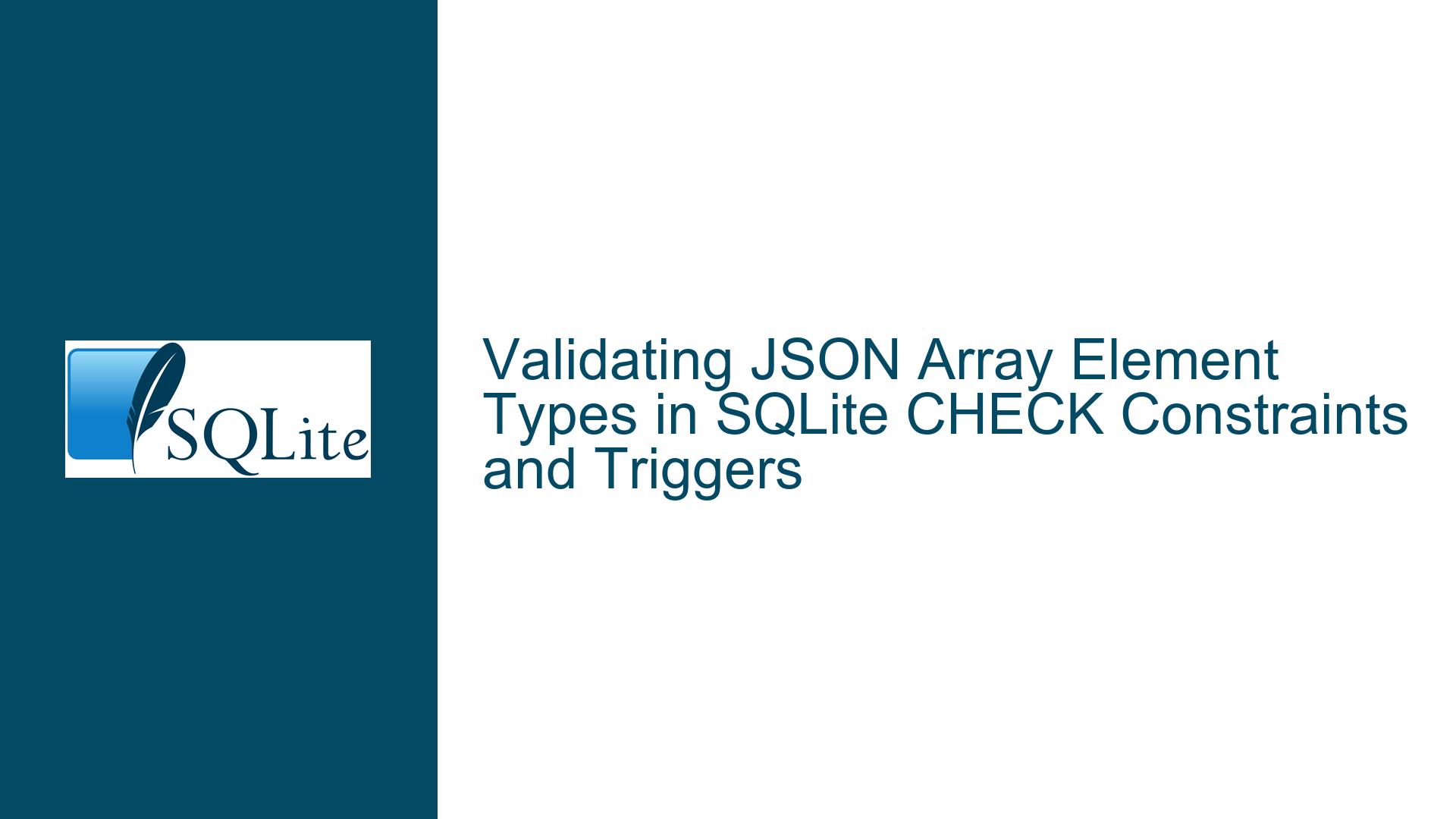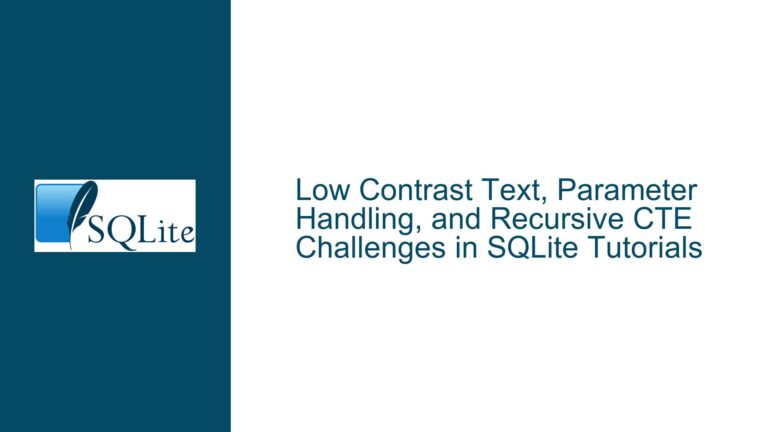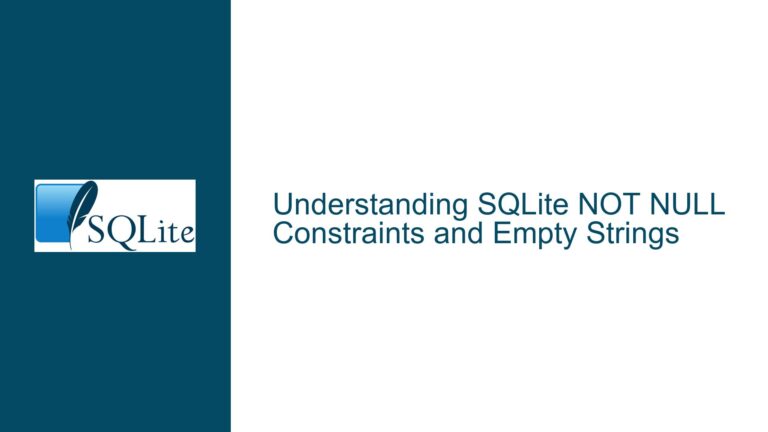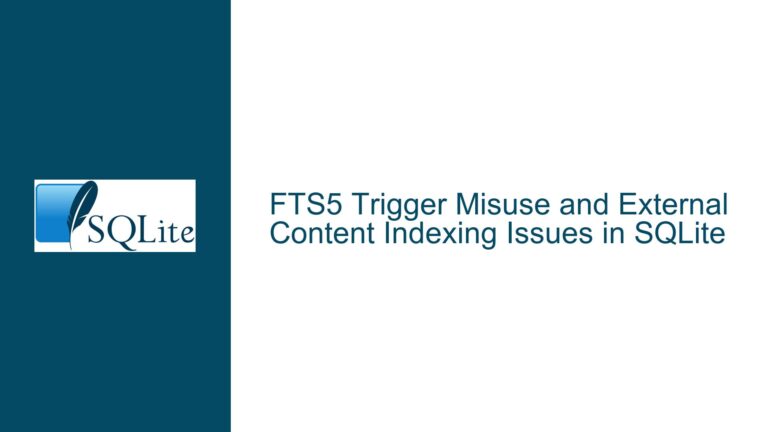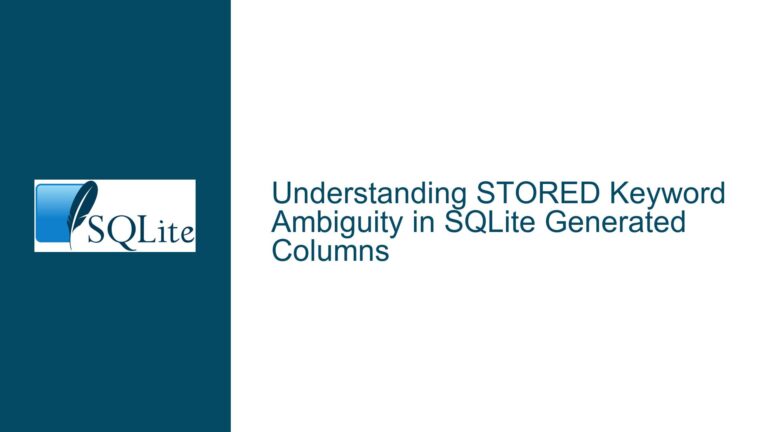Validating JSON Array Element Types in SQLite CHECK Constraints and Triggers
Understanding the Challenge of Enforcing JSON Array Element Type Consistency in SQLite CHECK Constraints
The problem at hand involves enforcing a data integrity rule within a SQLite database where a JSON array stored in a TEXT column must have all elements conform to a specific type for a given property. Specifically, the goal is to ensure that every object in the documentLines JSON array contains a title property of type text (JSON string). The initial attempt used a CHECK constraint with the json_type() function, but the path syntax failed to validate individual array elements. This scenario exposes fundamental limitations in SQLite’s JSON functionality when combined with constraint enforcement mechanisms.
Key Technical Limitations and Misconceptions
Path Syntax Limitations in
json_type():
Thejson_type(json, path)function returns the type of the JSON value at the specified path. When the path resolves to multiple elements (e.g., array members),json_type()returns'array'or'object'depending on the root structure, not the types of individual elements. Using'$.documentLines[*].title'as the path would attempt to resolve alltitleproperties across array elements, butjson_type()cannot iterate over these elements in a single call. The function evaluates the aggregate result of the path, not individual nodes.CHECK Constraint Restrictions:
SQLiteCHECKconstraints cannot execute subqueries, reference other tables, or utilize table-valued functions likeJSON_EACHorJSON_TREE. These constraints operate within a limited scope that prevents iterative validation of JSON array elements. ACHECKconstraint expecting to validate each element of an array would require logic equivalent to a loop, which SQLite’s constraint engine cannot natively execute.Trigger-Based Validation Requirements:
To perform row-level validation involving iteration over JSON structures, SQLite necessitates the use of triggers. Triggers can execute complex logic, including the use of table-valued JSON functions and conditional branching, making them the only viable mechanism for validating each element of a JSON array during data modification operations.
Root Causes of Validation Failure in CHECK Constraints and JSON Path Resolution
Incorrect Path Specification for Array Element Targeting
The original CHECK constraint used '$.documentLines.title' as the path argument to json_type(). This path does not account for the array structure of documentLines. In JSONPath syntax, $.documentLines.title would attempt to access a title property directly under documentLines, ignoring the array. To target elements within the array, the correct path should use the [*] wildcard: '$.documentLines[*].title'. However, even with this correction, json_type() would return 'array' if the path resolves to multiple values, not the types of individual elements.
Impossibility of Per-Element Validation in CHECK Constraints
SQLite CHECK constraints lack the capability to iterate over JSON array elements. Each constraint must evaluate to a boolean expression without side effects or dependencies on external data. When attempting to validate all elements of an array, a constraint would need to:
- Iterate through each element.
- Apply type-checking logic per element.
- Aggregate results to ensure all elements pass validation.
This is inherently impossible within a single CHECK constraint expression due to SQLite’s architectural constraints. The constraint engine cannot execute procedural logic or handle result sets returned by table-valued functions.
JSON Function Behavior in Aggregation Contexts
When using JSON functions like json_extract() with paths that resolve to multiple values, SQLite returns a JSON array containing all matched values. For example, json_extract(data, '$.documentLines[*].title') returns a JSON array of title values. The json_type() function applied to this result would return 'array', not the types of individual elements. Thus, any attempt to validate element types using json_type() in this manner would fail, as it cannot descend into the array to check each member.
Implementing Robust JSON Array Validation with Triggers and JSON_EACH
Step 1: Replace CHECK Constraint with Trigger-Based Validation
Since CHECK constraints cannot perform the required validation, replace them with BEFORE INSERT and BEFORE UPDATE triggers. These triggers will use the JSON_EACH table-valued function to iterate over each element in the documentLines array and validate the title property.
Trigger Structure for INSERT Operations:
DROP TRIGGER IF EXISTS tr_document_insert;
CREATE TRIGGER tr_document_insert
BEFORE INSERT ON document
FOR EACH ROW
BEGIN
SELECT RAISE(ABORT, 'Invalid title type in documentLines')
FROM (
SELECT
json_type(json_each.value, '$.title') AS title_type
FROM
json_each(json_extract(NEW.data, '$.documentLines'))
WHERE
title_type NOT IN ('text', 'null') -- Adjust based on nullability requirements
LIMIT 1
);
END;
Explanation:
json_extract(NEW.data, '$.documentLines')retrieves thedocumentLinesarray as a JSON string.json_each()converts this array into a virtual table where each row represents an array element.json_type(json_each.value, '$.title')extracts the type of thetitleproperty for each element.- The subquery checks for any element where
title_typeis not'text'(string) or'null'. If such an element exists,RAISE(ABORT)rolls back the operation.
Step 2: Handle UPDATE Operations with a Separate Trigger
To enforce validation during updates, create a similar trigger for BEFORE UPDATE:
DROP TRIGGER IF EXISTS tr_document_update;
CREATE TRIGGER tr_document_update
BEFORE UPDATE ON document
FOR EACH ROW
BEGIN
SELECT RAISE(ABORT, 'Invalid title type in documentLines')
FROM (
SELECT
json_type(json_each.value, '$.title') AS title_type
FROM
json_each(json_extract(NEW.data, '$.documentLines'))
WHERE
title_type NOT IN ('text', 'null')
LIMIT 1
);
END;
Step 3: Adjust Nullability and Type Requirements
Modify the WHERE clause in the triggers to reflect whether title can be NULL. In the original example, one title was null, which would fail if 'null' is excluded from the allowed types. To disallow null titles:
WHERE title_type != 'text'
Step 4: Validate JSON Structure Before Element-Type Checks
To prevent malformed JSON from being inserted, add a preliminary check using json_valid():
CREATE TRIGGER tr_document_insert
BEFORE INSERT ON document
FOR EACH ROW
BEGIN
-- Validate JSON structure
SELECT RAISE(ABORT, 'Invalid JSON data')
WHERE json_valid(NEW.data) = 0;
-- Validate title types
SELECT RAISE(ABORT, 'Invalid title type in documentLines')
FROM (
SELECT
json_type(json_each.value, '$.title') AS title_type
FROM
json_each(json_extract(NEW.data, '$.documentLines'))
WHERE
title_type != 'text'
LIMIT 1
);
END;
Step 5: Optimize Trigger Performance with EXISTS
Using EXISTS can improve performance by short-circuiting the check after the first invalid element is found:
CREATE TRIGGER tr_document_insert
BEFORE INSERT ON document
FOR EACH ROW
BEGIN
SELECT RAISE(ABORT, 'Invalid JSON data')
WHERE json_valid(NEW.data) = 0;
SELECT RAISE(ABORT, 'Invalid title type in documentLines')
WHERE EXISTS (
SELECT 1
FROM json_each(json_extract(NEW.data, '$.documentLines'))
WHERE json_type(value, '$.title') != 'text'
);
END;
Step 6: Handling Sparse or Optional Properties
If some elements in documentLines might lack a title property, use json_type() with a default value:
WHERE json_type(value, '$.title', 'absent') NOT IN ('text', 'null')
This treats missing title properties as 'absent', allowing explicit handling.
Step 7: Testing the Trigger with Sample Data
Valid Insert Example:
INSERT INTO document (id, data) VALUES ('2',
'{
"documentLines": [
{"title": "Valid Title", "lineNumber": "1"},
{"title": "Another Valid Title", "lineNumber": "2"}
]
}');
This should succeed as all title properties are strings.
Invalid Insert Example:
INSERT INTO document (id, data) VALUES ('3',
'{
"documentLines": [
{"title": 123, "lineNumber": "1"}
]
}');
This should fail with the "Invalid title type" error, as 123 is a JSON number.
Step 8: Extending Validation to Other JSON Types and Structures
The same approach can validate other JSON types (e.g., numbers, booleans) or nested structures. For example, to ensure lineNumber is a string containing a numeric value:
WHERE json_type(value, '$.lineNumber') != 'text'
OR json_extract(value, '$.lineNumber') GLOB '*[^0-9]*'
Step 9: Combining Multiple Validations in a Single Trigger
To validate multiple properties, combine conditions using AND/OR:
SELECT RAISE(ABORT, 'Validation failed')
WHERE EXISTS (
SELECT 1
FROM json_each(json_extract(NEW.data, '$.documentLines'))
WHERE
json_type(value, '$.title') != 'text' OR
json_type(value, '$.lineNumber') != 'text' OR
json_extract(value, '$.lineNumber') GLOB '*[^0-9]*'
);
Step 10: Considering Alternative Storage Designs
If JSON validation becomes overly complex, consider normalizing the schema by extracting documentLines into a separate table:
Normalized Schema:
CREATE TABLE document (
id TEXT PRIMARY KEY NOT NULL
) STRICT;
CREATE TABLE documentLine (
documentId TEXT NOT NULL,
lineNumber INTEGER NOT NULL,
title TEXT NOT NULL CHECK (typeof(title) = 'text'),
content TEXT NOT NULL,
FOREIGN KEY (documentId) REFERENCES document(id)
) STRICT;
This approach leverages SQLite’s native type checking and relational constraints but requires splitting JSON data into relational structures.
